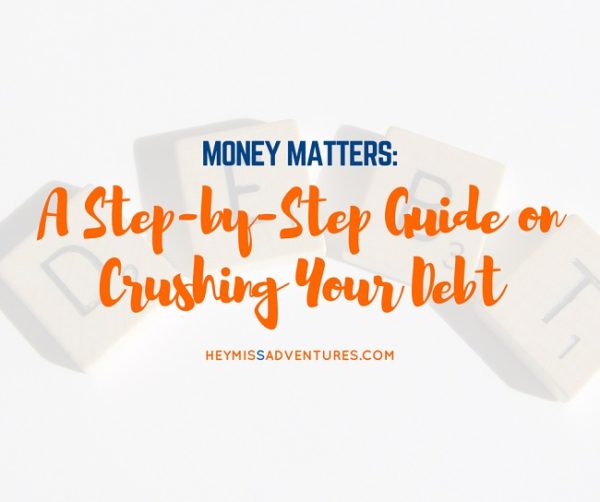A Step-by-Step Guide on Crushing Your Debt

Confession time: we are deep in debt, like 7-figure deep or so.
In our defense, about 90 percent of that is actually from our mortgage. We’ve been paying it for almost three years now which just goes to show just how little of your monthly dues goes to paying the principal amount. About ninety-percent of your money, during the first few years, goes to paying interest.
Another chunk of our debt is, embarrassingly, due to mismanagement of credit cards from two years ago. We surely are paying a huge price for it, literally and figuratively, but we are extremely determined to get rid of them this year and just be left with nothing but the mortgage.
How, you ask? Well, here’s our action plan:
1. Start with the end in mind.
This part is essentially figuring out your why. Why do you plan to get rid of debt? What is that major reason why you’d want to pay it all off, once and for all? (Aside from the fact that it keeps you up at night, not that it does that to me.)
If you can’t come up with any answer, just imagine waking up one day without any debt under your name. How awesome does that sound? And what will you do with all those freed-up funds? Just imagine how your life would be if you don’t have to live month after month chasing debt and bill payments, right?
2. List down all your debts.
Hopefully you’ve gone through all four stages of (debt) grief and you’re finally at the last part: acceptance. Time to face those monsters because they aren’t going away unless you tell them to.
List down every single debt that you currently owe: housing loans, student loans, car loans, personal loans, salary loans. Don’t forget to include credit card debts and all the money you owe friends and family.
I know summing up everything can feel overwhelming and discouraging but, you know what we will do? We’ll take it one baby step at a time.
3. Automate your payments.
Most banks actually have an auto debit feature or a payment scheduling system in them. Explore your banks online interface or visit the nearest branch and schedule all the debts and bills that you have, on or before they are due. Try to at least pay off the minimum payments but it is highly suggested to pay off everything, to avoid incurring interest.
4. Track down your cash flow.
Tracking your incoming and outgoing money is very important for a variety of reasons. Obviously, it tells you how much of your money is coming in and going out (and thus how much is staying it with you) every single day. Having this data will tell you if it’s time for a lifestyle change and if you need to cut off expenses in some, or all, aspects and if you need to ask for a pay raise or look for a side hustle to keep up with your lifestyle of choice. (We personally realized that we could only cut our expenses up to a point so I had to find a way to increase the money that was coming in.)
We currently use a fun budgeting tool called YNAB (You Need A Budget). It has been two months and I feel more in control of my finances than I have ever been. It uses zero-sum based budgeting which means that you need to provide a job for all your dollars, or peso in this case — which essentially means you need to allocate it to all your budget categories including savings.
Being the Type A person that I am, I also use my trusty spreadsheet to monitor daily income and expenses. This is really more to track how much we are spending on groceries and other house expenses, which the partner takes care of. And, since I am now treating my freelance work, I also carefully monitor my business income and expenses through bookkeeping tools like Dubsado and WaveApps. (Of course, I have two!)
5. Build a backup fund.
This is really where we constantly fail at and one we are still trying to build. Ideally, you should have 3 to 6 months’ worth of expenses stashed as liquid assets but based on Dave Ramsey’s baby step, you can start off at $1,000 or around Php 50,000 before paying off your debts.
The reason for this is to simply make sure that you have something to fall back on in case of emergencies (and nope, a sale is not an emergency). Without it, you could get yourself into further debt, which we have gone through multiple times in the past.
6. Come up with a debt repayment plan.
There are several ways to tackle debt. There’s the debt snowball, which means paying off your debts from smallest to biggest and then there’s the debt avalanche, which is the exact opposite. Or you can also pay it off based on interest rates instead of the entire amount owed.
What’s the best approach, you ask? Like everything else in personal finance, it’s personal, so it ultimately depends upon you. However, I do recommend the debt snowball method as it gives some sort of instant gratification. Isn’t it encouraging when you start slashing off one debt category after another?
7. Find an accountability partner.
Money is one of those touchy subjects you’d rather not discuss with strangers or even friends. If you can find a good accountability partner, then good for you. If you’re a couple, then definitely get your partner or spouse on board. Internet groups and even blogging about it works great, too.
The most important thing here is to find someone who will encourage you when you’re feeling demotivated and are about to fall off the wagon, and to give you a pat on the back if you’ve done an awesome job.
8. Celebrate your milestones.
Debt fatigue is real. When you’ve been paying your debt month after month and cannot seem to see any progress, it’s easy to get discouraged and exhausted. Don’t forget to celebrate milestones such as when you’ve paid up six figures worth of debt or when your down to your last 100,000 or 10,000. Go out and splurge (a little) and stop feeling guilty!
One of our major milestones is happening by the end of this year because we will have finally paid off our house’s equity by then. Hooray! If things go as planned, we’d have been able to finish paying off all our other debts, a total of around six figures, all in all.
Whew. Now go and get yourself to work. And crush that debt hard. You can do this!

Oh, hello there!
Pam is an outdoors-loving millennial momma who loves to hike, trek and camp in the beaches and mountains with her partner and their kiddos. When not exploring the great outdoors, she works with bloggers, coaches and solopreneurs to free up their time so they can work on the things that they love and enjoy the most.











Happy to have read this! Since I don’t have any debt right now (hooray for being single!) but this greatly helps. Never to any negative debts ahead!